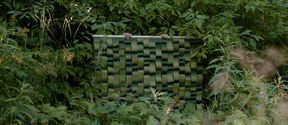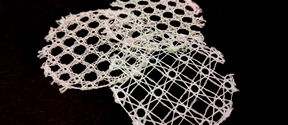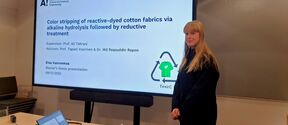DIALOGUES – Creating New Textile Futures exhibition in Dipoli Gallery
The exhibition features research projects and student works related to textiles at Aalto University.

Interwoven – Exploring Materials and Structures by Maarit Salolainen, (Aalto ARTS Books, 2022) makes a considerable effort to outline how the manifold history of textiles has been intertwined with human innovation from prehistoric twining to the invention of the binary code, through to today’s new material discoveries and the urgent quest for sustainability.
The book includes contributions by lecturers Maija Fagerlund, Anna-Mari Leppisaari, professor Kirsi Niinimäki and Aalto University graduates. The photography is by Aalto alumna Eeva Suorlahti.
‘I wanted to make a book on fibres, yarns, structures of the textiles and the pedagogy of Aalto in teaching textile design. There had been no such book done, and now I know why – it was a challenge!’ laughs Maarit Salolainen, Adjunct Professor of textile design and director of the Fashion, Clothing and Textiles (FaCT) Master's programme at Aalto University.
Salolainen says her core message throughout the book is that one has to know how to use techniques and be creative with them – and to see into the future.
The majestic book guides the reader into textile materials and structures and woven fabrics, advancing to jacquards, textile finishes and applications. It introduces the process of design and visual research, as well as the principles of collection design.
Interwoven discusses how textile making, throughout history, has catalysed and changed human thinking. It tells the history of the textile industry from its beginning to modern times and beyond, envisioning the future potential.
Salolainen believes the book will interest designers and design collaborators alike. It also aims to add to design pedagogy's international debate on design as learning.
The new pedagogical method introduced in Interwoven is a tool for woven design teaching, which helps create a multi-disciplinary learning environment. Textile thinking strives for a holistic understanding of textiles. The method guides professional textile design practices and processes, renewing the way in which textile design has been taught. It also helps open up the essence of techniques and craft and design practices. The pedagogical model can be applied to another teaching as well.
'Textile thinking is embodied thinking. It is the way of combining tacit knowledge guided by emotions together with the understanding of the mechanisms in textiles – in short, it bridges the creative and the technical’, says Salolainen.
The book is grounded in design pedagogy and the principles of learning design by doing. It interweaves technical knowledge, artistic expression and storytelling, making it a unique guide to mastering textile design. What is important, it includes the creative aspects of textile design. Emphasis is placed on experimentation and tips on how to do this without forgetting the importance of mastering technical skills up to computer-aided design.
Professor Maarit Salolainen“The ability to imagine new sustainable design solutions is encouraged."
What is of great importance, the book powerfully addresses environmental concerns, which are fundamental to the future of textiles and fashion. When discussing the textile lifecycle, all phases must be considered: fibre cultivation, material manufacturing, yarn spinning, weaving, dyeing and printing processes, different finishing options and logistics phases, and the use and the end-of-life stages. Information on the sustainability of textiles is provided throughout the book. The section written by professor Kirsi Niinimäki on the environmental impact of textile fibres deep-dives into the theme.
‘I want to encourage students to fearlessly tackle technical knowledge as they are learning-by-doing and, what is exceedingly important, to utilise this knowledge to understand the complexity of the environmental impact of textiles to work towards new solutions for sustainable textile futures’, Salolainen explains.
In the foreword of the book, textile designer, Professor Emerita and former Dean of Aalto University School of Arts, Design and Architecture Helena Hyvönen recalls that the elementary aim during her period as a Dean was to aim for a comprehensive and shared design approach.
Part of that was the aspiration to weave together the Textiles and Fashion Studies programmes as closely as possible and to envision what role textiles and fashion can have in design pedagogy.
‘A significant leap towards interdisciplinary learning between the fields was taken by investing in fashion and textile studios, and developing the curricula towards learning by making’, Hyvönen says.
Back then, central to the teaching approach was to focus student time on the essentials; teaching design thinking, producing content and weaving a narrative, and developing technical skills efficiently.
‘Testament to this approach are the various successful careers our students have gone on to have in the textile industry and international fashion houses, not to mention the BA Programme in Fashion and MA Programme in Fashion, Clothing and Textile Design which reached the top of the Business of Fashion ranking in 2019.’
Today, Aalto University’s top-level studios and workshop infrastructure have become the core in promoting learning by doing. Aalto’s expertise in fashion and textiles is unique in the world.
Professor Maarit Salolainen has worked in the field of textiles since her graduation from the University of Art and Design Helsinki in the early 90s. She recalls her early textile student times when facing an assignment in the woven fabrics class and how challenging it was as theory and practice were taught very separately. Students then worked on their own, separate warps on their own project, and It was difficult to gain information and understanding of the process as a whole, and try out different materials and structures.
‘It took me years to gain enough experience of different types of warps, textile fibres, yarns and woven structures to feel confident in my ability to design woven fabrics.’
These experiences were clear in her mind as she started to develop and renew the textile and surface design courses at Aalto University School of Arts, Design and Architecture in 2006. Working as a creative director of a weaving mill, her point of view on textile design was from within the industry and business. She sought to bring the design practices of a professional design team to the textile studios of Aalto University.
Aalto’s students already create a versatile fabric collection at the beginning of woven textile design studies, which increases their practical knowledge of textile fibre properties and yarns and their behaviour and relation to different weave structures. This way, the practice-led, creative research process is integral to textile technology studies. Students advance quickly to combined weaves and jacquards to innovate, implement and apply their skills in textiles and fashion or other domains.
Educating designers with ‘hybrid’ skills is vital for Salolainen. ‘The ability to imagine new sustainable design solutions is encouraged.’

Back to history: The invention of the jacquard loom marks the start of the digital age. At the beginning of the 19th century, Joseph Jacquard’s invention of the jacquard loom stored information for the first time in binary format on its perforated cardboard cards and laid the ground for automatic information processing, computers and data networks.
‘Today, textile structures and materials are applied in novel medical applications, electronics are incorporated into woven textiles, and new fibres reform the future – textiles remain at its core. We might be on the verge of a new era resembling the revolution which the jacquard loom's invention started’, says Salolainen.
The Interwoven book is available in the Aalto University Shop
Aalto textile students' works were on display at the DIALOGUES exhibition in New York 2-6 November, 2022. The Dialogues by AaltoTEXTILES exhibition is on display at Dipoli in Otaniemi from the end of November to February 2023. The exhibition features research projects and student works related to textiles at Aalto University.
Visit the virtual exhibition
Contact:
Maarit Salolainen, Adjunct Professor in Textile Design, Aalto University School of Arts, Design and Architecture, maarit.salolainen@aalto.fi, +358504428381

The exhibition features research projects and student works related to textiles at Aalto University.

DIALOGUES event in New York 2–6 November reimagines the landscape of tomorrow’s textiles and fashion



